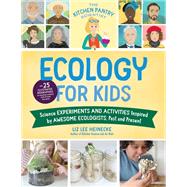This engaging guide offers a series of snapshots of 25 scientists famous for their work with ecology. Each lab tells the story of a scientist along with some background about the importance of their work, and a description of where it is still being used or reflected in today’s world.
A step-by-step illustrated experiment paired with each story offers kids a hands-on opportunity for exploring concepts the scientists pursued, or are working on today. Experiments range from very simple projects using materials you probably already have on hand, to more complicated ones that may require a few inexpensive items you can purchase online. Just a few of the incredible people and scientific concepts you’ll explore:
Eunice Newton Foote (b. 1819)
See how carbon dioxides trap heat
George Washington Carver (b. 1864)
Grow beans and study soil conditions
Rachel Carson (b. 1907)
Test the water clarity from local ponds, lakes, or steams
E. O. Wilson (b. 1929)
Observe insects in their natural habitats
With this fascinating, hands-on exploration of the history of ecology, inspire the next generation of great scientists.
Dig into even more incredible science history from The Kitchen Pantry Scientist series with: Chemistry for Kids, Biology for Kids, Physics for Kids, and Math for Kids.








